Vector Wizard
Mendelgen features a Vector Wizard to create optimized viral vectors for expression in target cell types for gene therapy experiments. However, it's crucial to note that these vectors are designed solely for in vitro research and experimental purposes. They are not intended for use in living subjects, including both humans and animals. To access the Vector Wizard, on the Dashboard, select New Vector -> Viral vector wizard
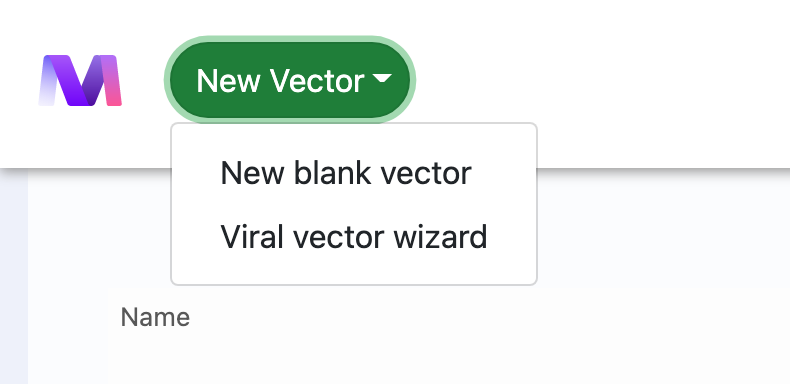
In the pop-up window you can see the options:
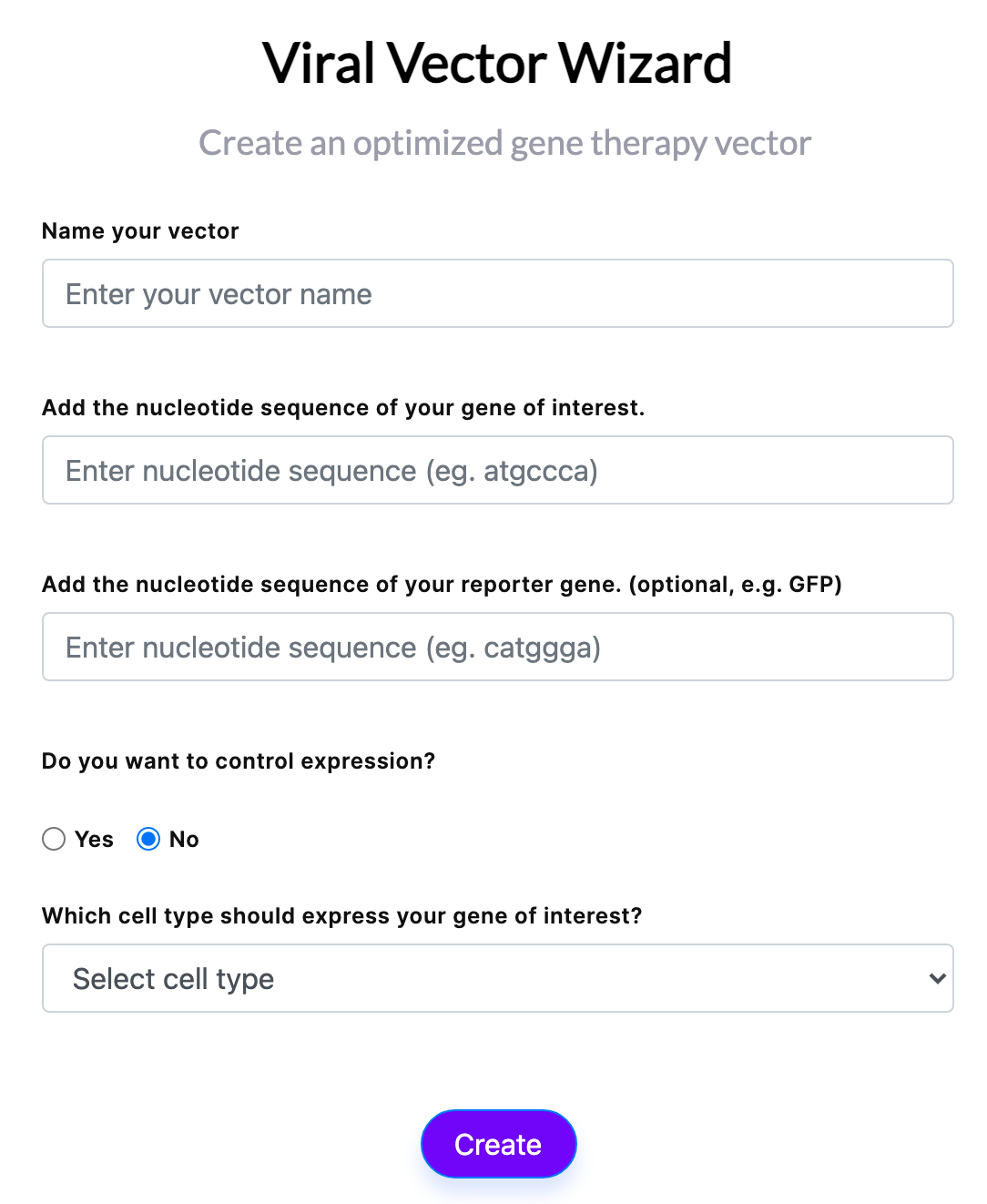
After naming your new vector, add the sequence of your insert (gene of interest). Please use the nucleotide sequence. If you have a reporter gene, add the sequence in the field below.
You can also select the target cell type for expression. Currently available target tissues and cell types: CNS, heart, kidney, liver, lung, pancreas, eye, skeletal muscle, and systemic (no specific cell type). Selecting either of them results in adding a tissue-specific promoter to your vector.
For example, if I would like to express the MMP1 gene, I would obtain the sequence from NCBI (gene ID 4312, human, NCBI Reference Sequence: NM_001145938.2).
atattggagcagcaagaggctgggaagccatcacttaccttgcactgagaaagaagacaaaggcaagttgaaaagcggagaaatagtggcccagtggttgaaaaattgaagcaaatgcaggaattctttgggctgaaagtgactgggaaaccagatgctgaaaccctgaaggtgatgaagcagcccagatgtggagtgcctgatgtggctcagtttgtcctcactgaggggaaccctcgctgggagcaaacacatctgacctacaggattgaaaattacacgccagatttgccaagagcagatgtggaccatgccattgagaaagccttccaactctggagtaatgtcacacctctgacattcaccaaggtctctgagggtcaagcagacatcatgatatcttttgtcaggggagatcatcgggacaactctccttttgatggacctggaggaaatcttgctcatgcttttcaaccaggcccaggtattggaggggatgctcattttgatgaagatgaaaggtggaccaacaatttcagagagtacaacttacatcgtgttgcagctcatgaactcggccattctcttggactctcccattctactgatatcggggctttgatgtaccctagctacaccttcagtggtgatgttcagctagctcaggatgacattgatggcatccaagccatatatggacgttcccaaaatcctgtccagcccatcggcccacaaaccccaaaagcgtgtgacagtaagctaacctttgatgctataactacgattcggggagaagtgatgttctttaaagacagattctacatgcgcacaaatcccttctacccggaagttgagctcaatttcatttctgttttctggccacaactgccaaatgggcttgaagctgcttacgaatttgccgacagagatgaagtccggtttttcaaagggaataagtactgggctgttcagggacagaatgtgctacacggataccccaaggacatctacagctcctttggcttccctagaactgtgaagcatatcgatgctgctctttctgaggaaaacactggaaaaacctacttctttgttgctaacaaatactggaggtatgatgaatataaacgatctatggatccaggttatcccaaaatgatagcacatgactttcctggaattggccacaaagttgatgcagttttcatgaaagatggatttttctatttctttcatggaacaagacaatacaaatttgatcctaaaacgaagagaattttgactctccagaaagctaatagctggttcaactgcaggaaaaattgaacattactaatttgaatggaaaacacatggtgtgagtccaaagaaggtgttttcctgaagaactgtctattttctcagtcatttttaacctctagagtcactgatacacagaatataatcttatttatacctcagtttgcatatttttttactatttagaatgtagccctttttgtactgatataatttagttccacaaatggtgggtacaaaaagtcaagtttgtggcttatggattcatataggccagagttgcaaagatcttttccagagtatgcaactctgacgttgatcccagagagcagcttcagtgacaaacatatcctttcaagacagaaagagacaggagacatgagtctttgccggaggaaaagcagctcaagaacacatgtgcagtcactggtgtcaccctggataggcaagggataactcttctaacacaaaataagtgttttatgtttggaataaagtcaaccttgtttctactgtttta
After copying and pasting the nucleotide sequence, I have new options appearing:
- Will the gene be integrated into host DNA?
- Is it in vivo experiment?
- Will the expression be controlled?
Follow the diagram below to see the variety of options available.
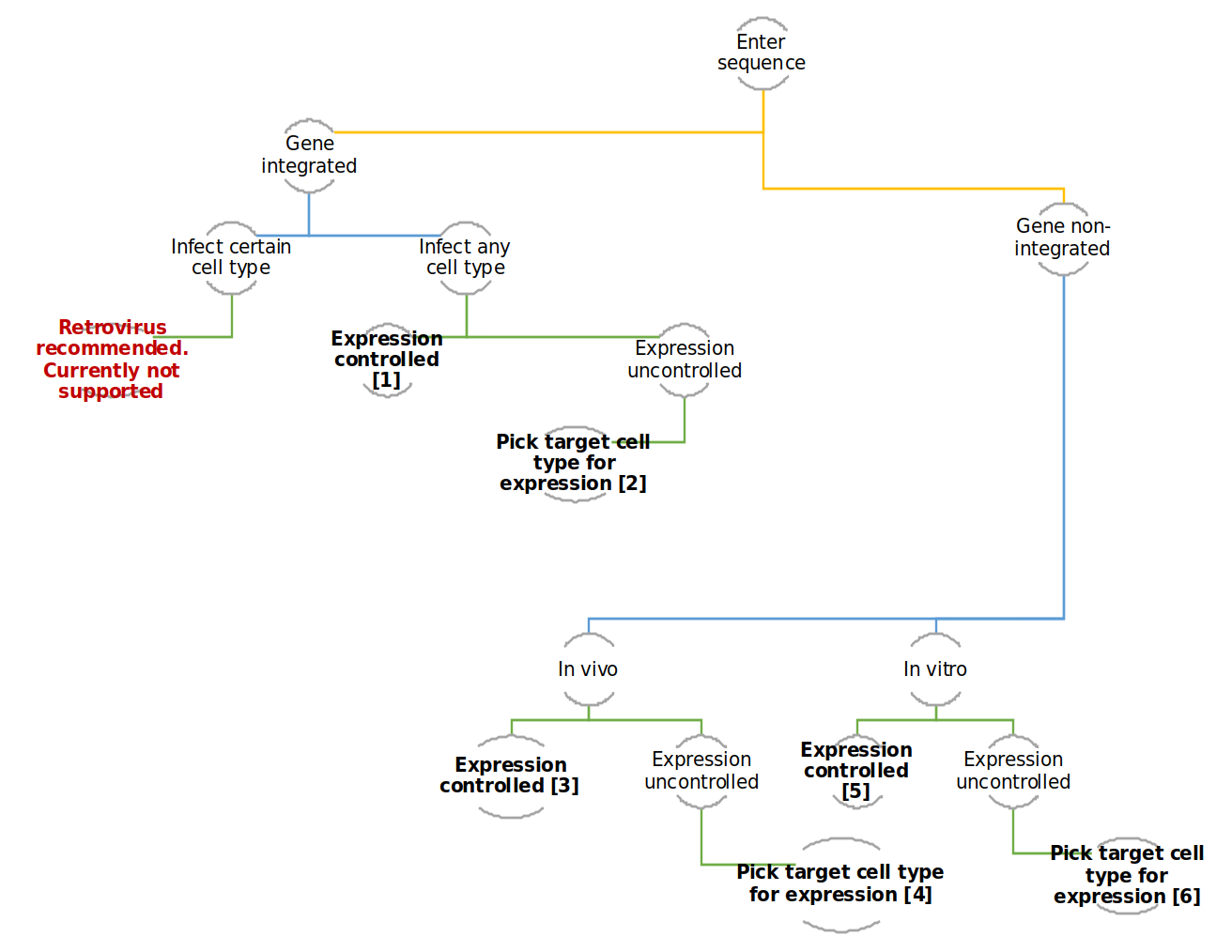
| Gene integrated | In vivo | Expression controlled | Antibiotic | Promoter | Tet operator | Lac operator | AAV2 ITR | RRE | Core vector | ||
|---|---|---|---|---|---|---|---|---|---|---|---|
| [1] Gene integrated + in any cells + expression co | Yes | Yes | No | AmpR | T3, T7 | Yes | Yes | No | Yes | 3rd generation lentiviral vector | |
| [2] Gene integrated + in any cells + expression uncontrolled – in heart | Yes | Yes | Yes | AmpR | T3, T7, RSV | No | Yes | No | Yes | 3rd generation lentiviral vector | |
| [3] Gene non-integrated + in vivo + expression controlled | No | Yes | Yes | AmpR | EF1a | Yes | No | Yes | No | 3rd generation lentiviral vector | |
| [4] Gene non-integrated + in vivo + expression uncontrolled – in heart | No | Yes | No | AmpR | Tissue specific + EF1a | No | No | Yes | No | AAV vector expressing Myc-tagged SpCas9 under the EFS promoter | |
| [5] Gene non-integrated + in vitro + expression controlled | No | No | Yes | KanR/NeoR | Tissue specific | Yes | No | Yes (ITR) | No | NA | |
| [6] Gene non-integrated + in vitro + expression uncontrolled – in heart | No | No | No | KanR/NeoR | Tissue specific | No | No | Yes (ITR) | No | NA |
Tissue specific promoters
| Promoter | Citation | ||
|---|---|---|---|
| CNS | Astrocytes | Minimal GFAP | 1) Lee Y, Messing A, Su M, Brenner M. GFAP promoter elements required for region-specific and astrocyte-specific expression. Glia. 2008 Apr;56(5):481-93. doi: 10.1002/glia.20622. PMID: 18240313. 2)Kügler S. Tissue-Specific Promoters in the CNS. Methods Mol Biol. 2016;1382:81-91. doi: 10.1007/978-1-4939-3271-9_6. PMID: 26611580. |
| Neurons | Minimal human synapsin promoter | Dashkoff J, Lerner EP, Truong N, et al. Tailored transgene expression to specific cell types in the central nervous system after peripheral injection with AAV9. Mol Ther Methods Clin Dev. 2016;3:16081. Published 2016 Dec 7. doi:10.1038/mtm.2016.81 | |
| Heart | Cardiocytes | Cardiac tropin T promoter | Lin Z, Zhou P, von Gise A, et al. Pi3kcb links Hippo-YAP and PI3K-AKT signaling pathways to promote cardiomyocyte proliferation and survival. Circ Res. 2015 Jan 2;116(1):35-45. doi: 10.1161/CIRCRESAHA.115.304457. Epub 2014 Sep 23. PMID: 25249570; PMCID: PMC4282610. |
| Cardiocytes (minimal) | Minimal MLC2v | Phillips MI, Tang Y, Schmidt-Ott K, Qian K, Kagiyama S. Vigilant vector: heart-specific promoter in an adeno-associated virus vector for cardioprotection. Hypertension. 2002 Feb;39(2 Pt 2):651-5. doi: 10.1161/hy0202.103472. PMID: 11882625. | |
| Kidney | Minimal KSPC | 1) Shao X, Johnson JE, Richardson JA, et al. A minimal Ksp-cadherin promoter linked to a green fluorescent protein reporter gene exhibits tissue-specific expression in the developing kidney and genitourinary tract. J Am Soc Nephrol. 2002 Jul;13(7):1824-36. doi: 10.1097/01.asn.0000016443.50138.cd. PMID: 12089378. 2)Asico LD, Cuevas S, Ma X, Jose PA, Armando I, Konkalmatt PR. Nephron segment-specific gene expression using AAV vectors. Biochem Biophys Res Commun. 2018;497(1):19-24. doi:10.1016/j.bbrc.2018.01.169 | |
| Liver | TBG promoter | Kattenhorn LM, Tipper CH, Stoica L, et al. Adeno-Associated Virus Gene Therapy for Liver Disease. Human Gene Therapy. 2016 27:12, 947-961. doi: 10.1089/hum.2016.160 | |
| Lung | CASI (artificial promoter made of CMV enhancer, chicken beta actin promoter, Splice Donor, UBC Enahcner, Splice acceptor) | Chew WL, Tabebordbar M, Cheng JK, et al. A multifunctional AAV-CRISPR-Cas9 and its host response. Nat Methods. 2016 Oct;13(10):868-74. doi: 10.1038/nmeth.3993. Epub 2016 Sep 5. PMID: 27595405; PMCID: PMC5374744. | |
| Pancreas | Rat progluclan promoter | Chew WL, Tabebordbar M, Cheng JK, et al. A multifunctional AAV-CRISPR-Cas9 and its host response. Nat Methods. 2016 Oct;13(10):868-74. doi: 10.1038/nmeth.3993. Epub 2016 Sep 5. PMID: 27595405; PMCID: PMC5374744. | |
| Eye | Minimal promoter derived from GRM6 human gene (770En_454P(hGRM6)) | Hulliger EC, Hostettler SM, Kleinlogel S. Empowering Retinal Gene Therapy with a Specific Promoter for Human Rod and Cone ON-Bipolar Cells. Mol Ther Methods Clin Dev. 2020;17:505-519. Published 2020 Mar 13. doi:10.1016/j.omtm.2020.03.003 | |
| Skeletal muscle | Sk-CRM4 (435 bp) (green) + Dsm promoter (983 bp) | Sarcar S, Tulalamba W, Rincon MY, et al. Next-generation muscle-directed gene therapy by in silico vector design. Nat Commun. 2019 Jan 30;10(1):492. doi: 10.1038/s41467-018-08283-7. PMID: 30700722; PMCID: PMC6353880. | |
| Systemic (no specific cell type | CMV promoter and enhancer | NA |
We will demonstrate these options on examples below:
1) Gene integrated + in any cells + expression controlled
Vector: 3rd generation lentiviral vector.

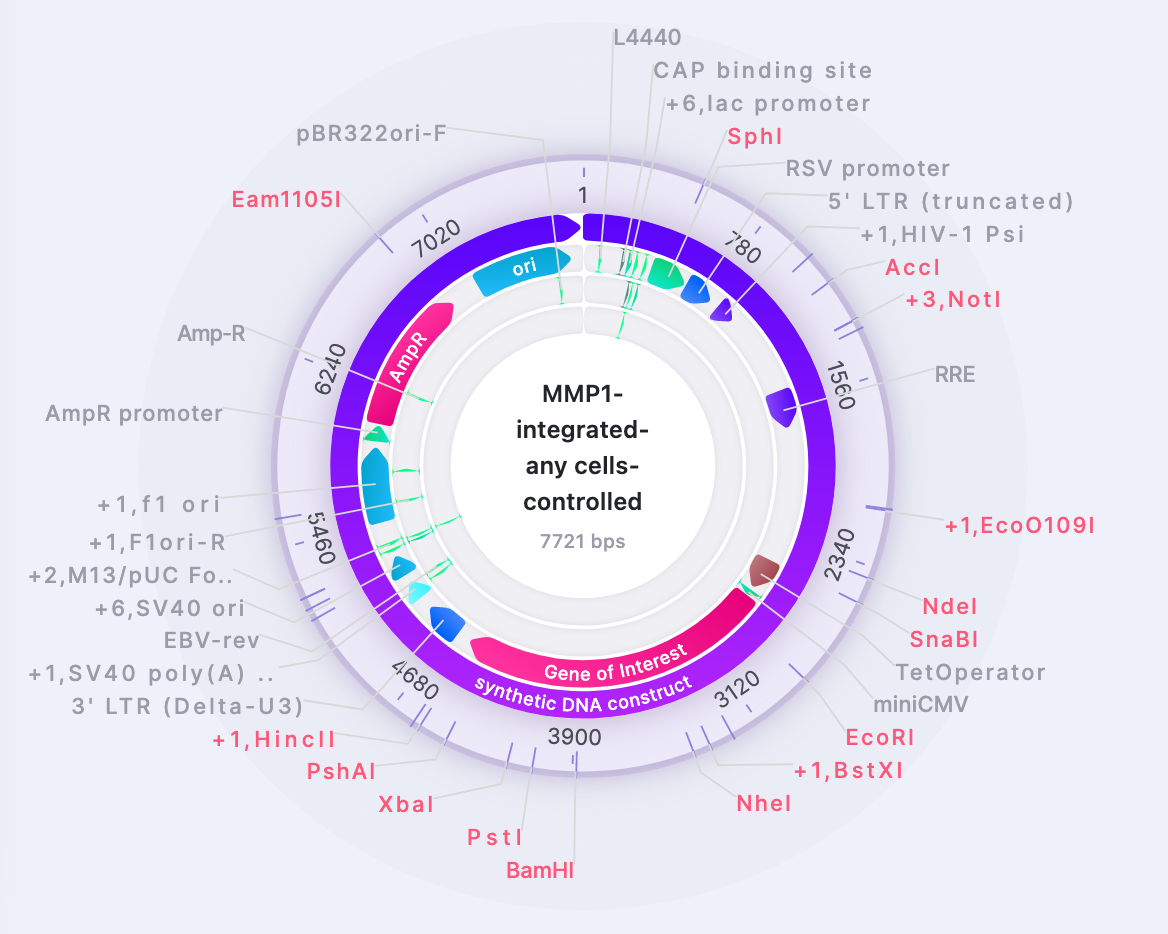
The main vector features:
- 3’LTR (Delta-U3)
- 5’LTR truncated
- AmpR and AmpR promoter
- CAP binding site
- F1 ori
- HIV-1 Psi
- Lac operator and lac promoter
- Mini CMV
- Ori
- RRE
- RSV promoter
- SV40 ori
- SV40 poly(A) signal
- T3 promoter
- T7 promoter
- Tet operator
2) Gene integrated + in any cells + expression uncontrolled – in heart
Vector: 3rd generation lentiviral vector.
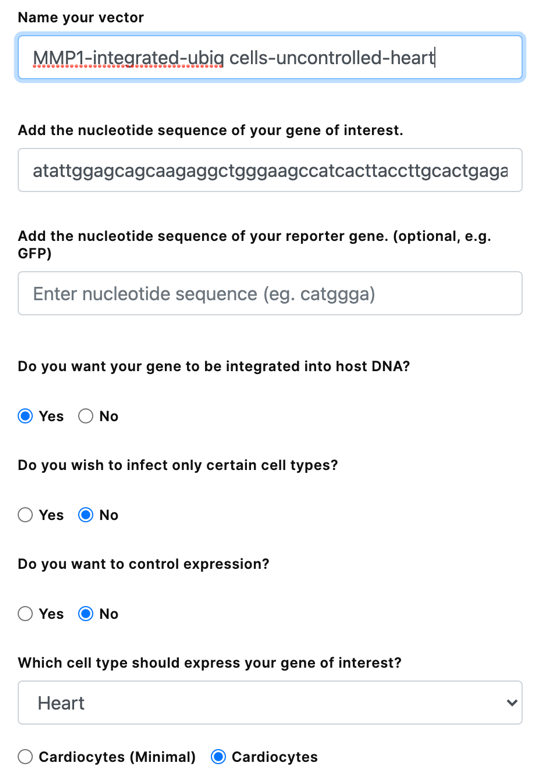
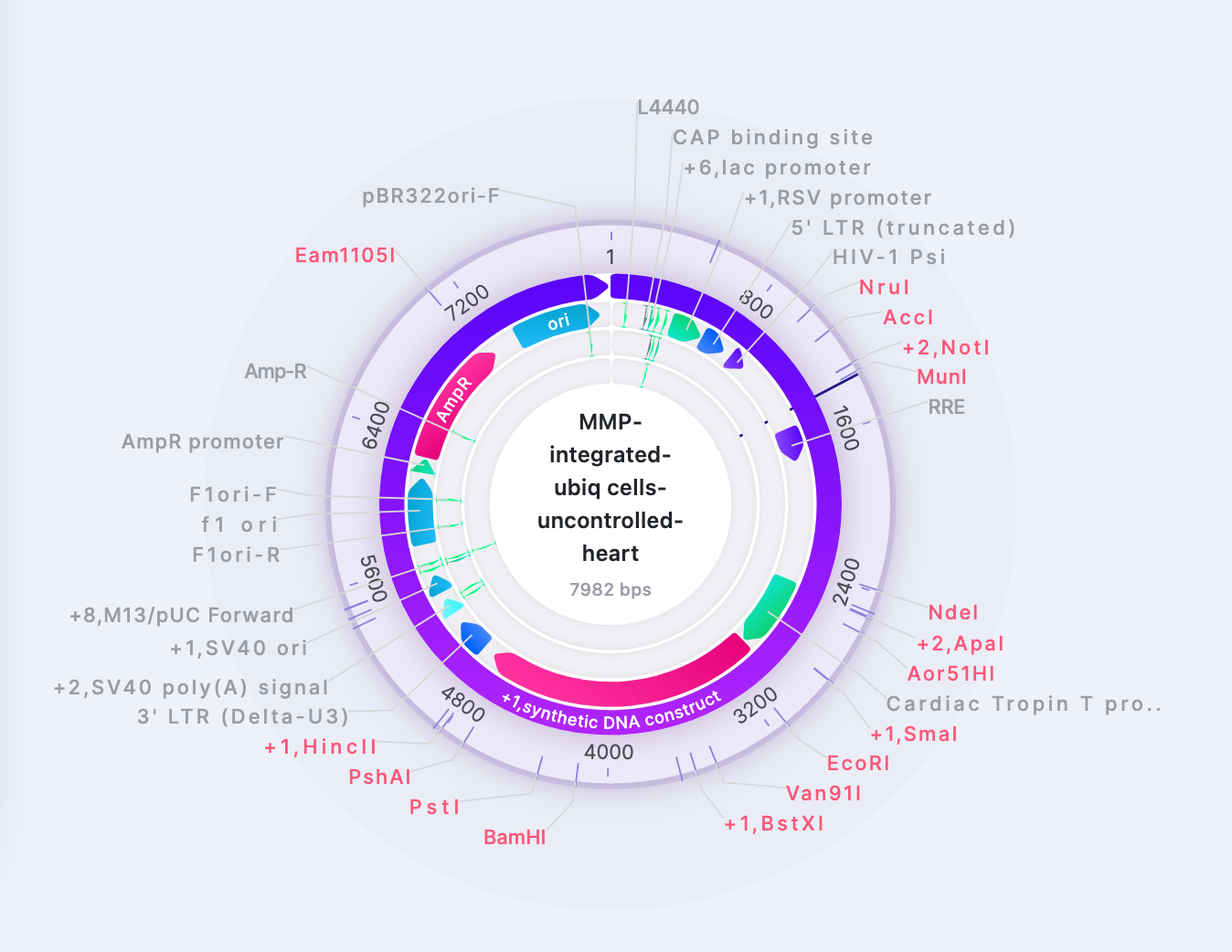
Main vector features:
- 3’-LTR (Delta-U3)
- 5’LTR truncated
- AmpR nd AmpR promoter
- CAP binding site
- Cardiac tropin T promoter
- F1 ori
- HIV-1 Psi
- Lac operator and lC promoter
- Ori
- RRE
- RSV promoter
- SV40 ori
- SV40 poly(A) signal
- T3 promoter
- T7 promoter
3) Gene non-integrated + in vivo + expression controlled
Vector: AAV vector expressing Myc-tagged SpCas9 under the EFS promoter.
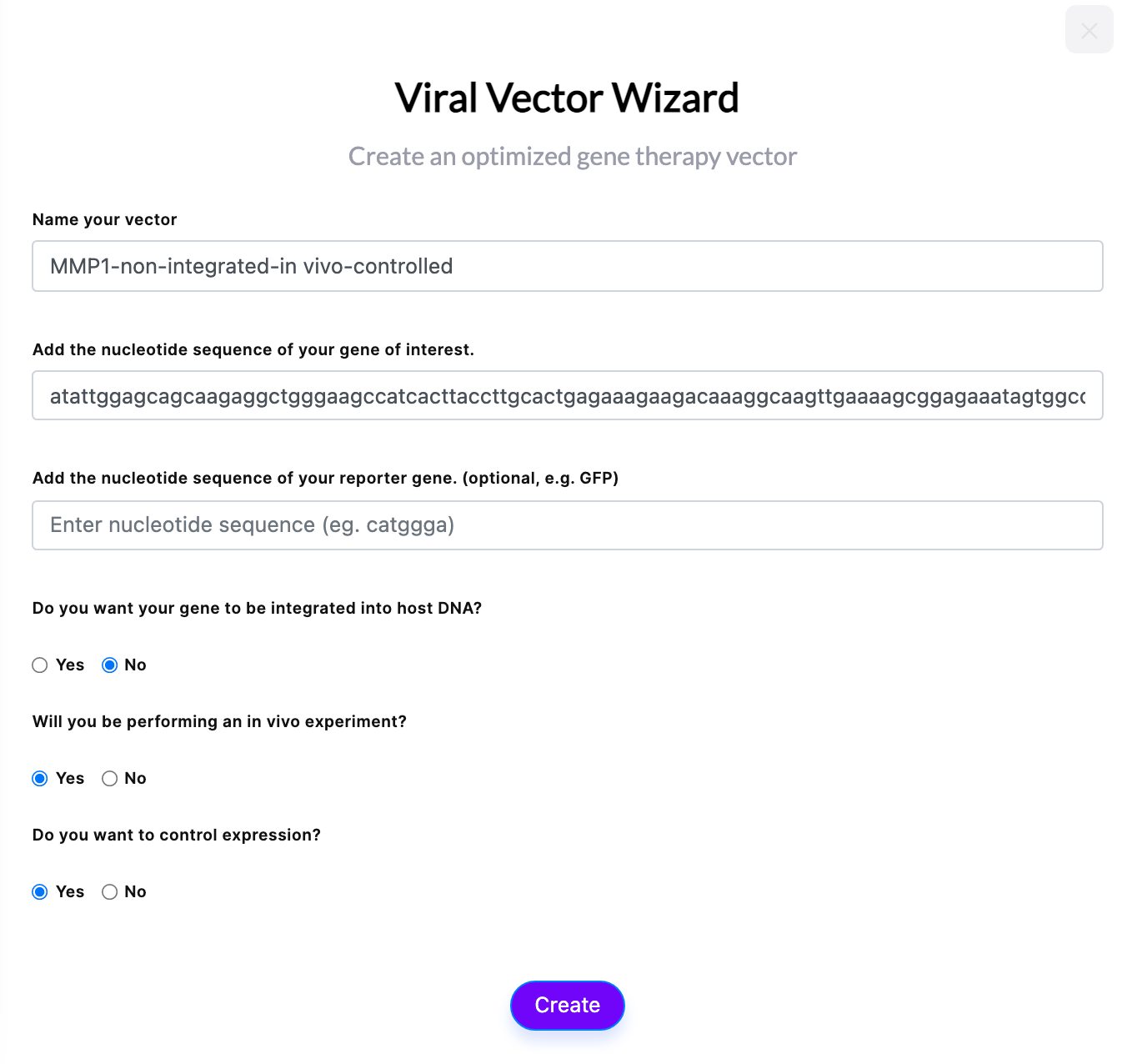
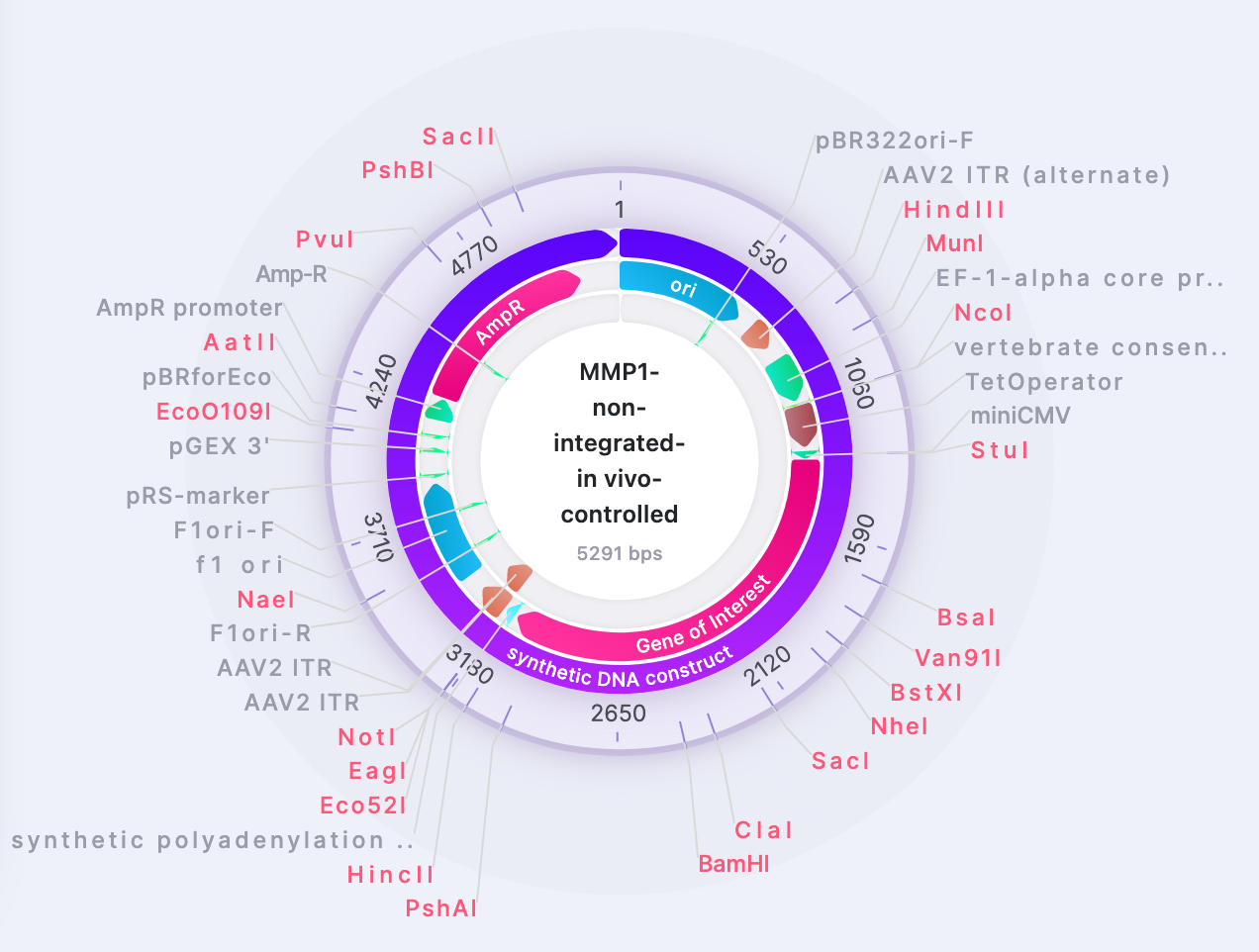
Main vector features:
- AAV2 ITR (alternate)
- AmpR and AmpR promoter
- EF-1-alpha core promoter
- F1 ori
- Mini CMV
- Ori
- Synthetic polyA signal
- Tet operator
- Vertebrate consensus sequence for strong initiation (Kozak)
4) Gene non-integrated + in vivo + expression uncontrolled – in heart
Vector: AAV vector expressing Myc-tagged SpCas9 under the EFS promoter.
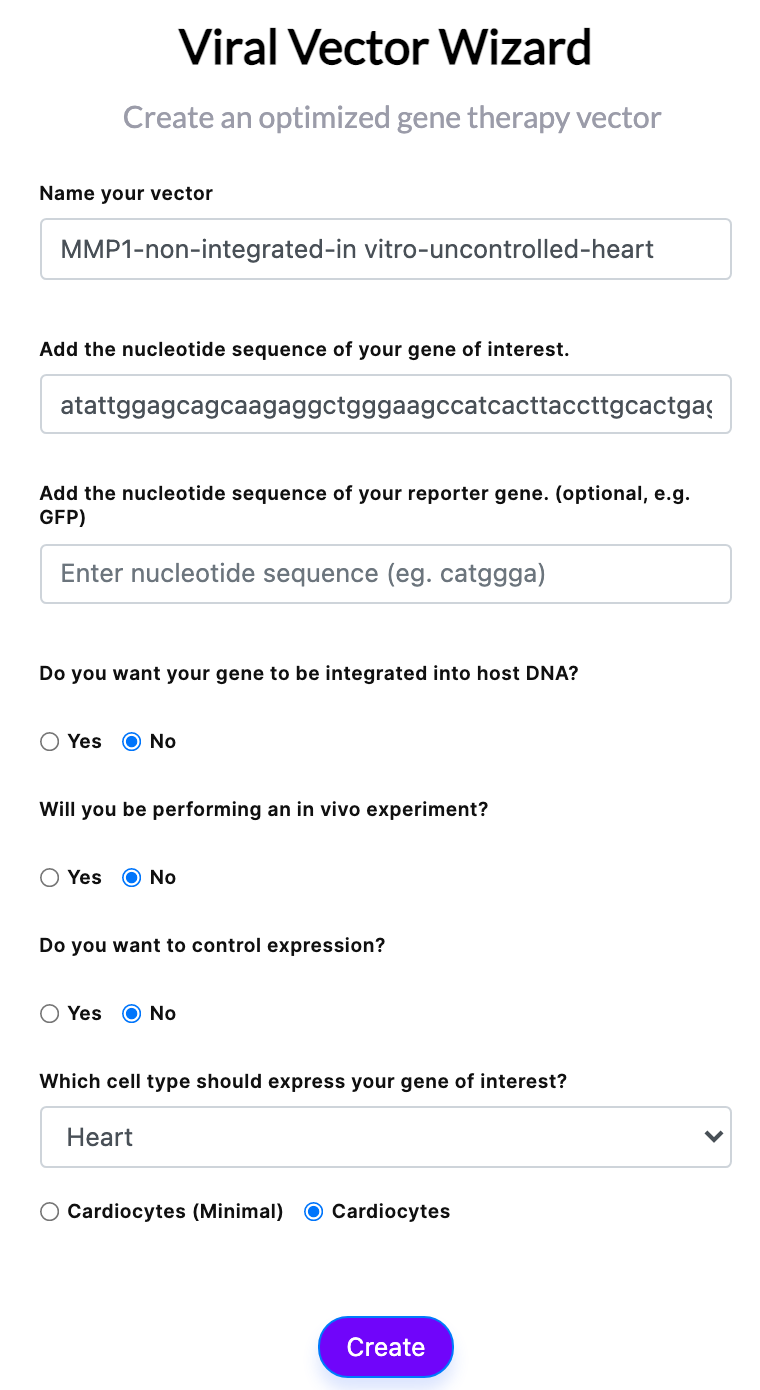
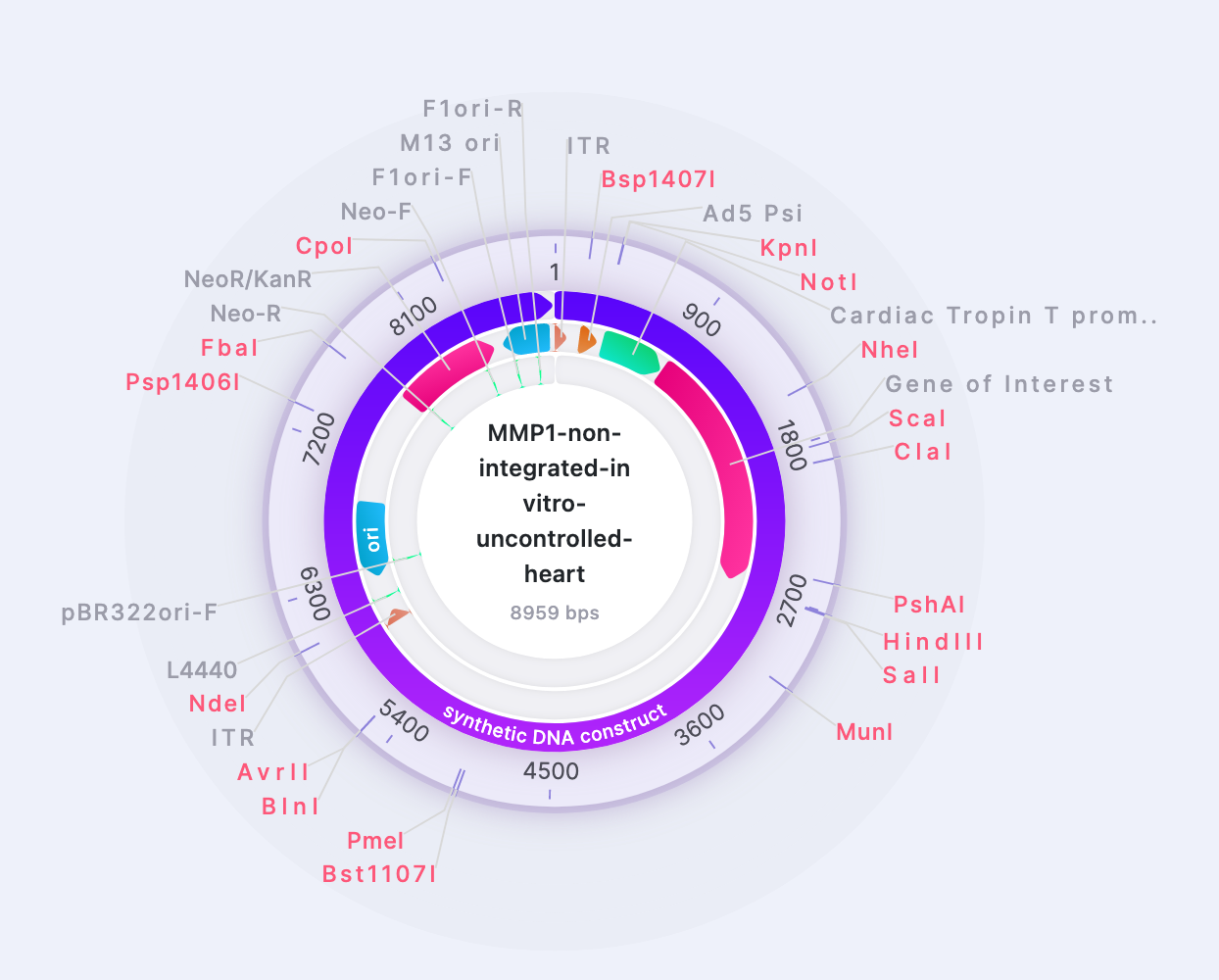
Main vector features:
- AAV2 ITR
- AAV2 ITR (alternate)
- AmpR
- AmpR promoter
- Cardiac tropin T promoter (tissue-specific promoter)
- EF-1-alpha core promoter
- F1 ori
- Ori
- Synthetic polyA signal
5) Gene non-integrated + in vitro + expression controlled

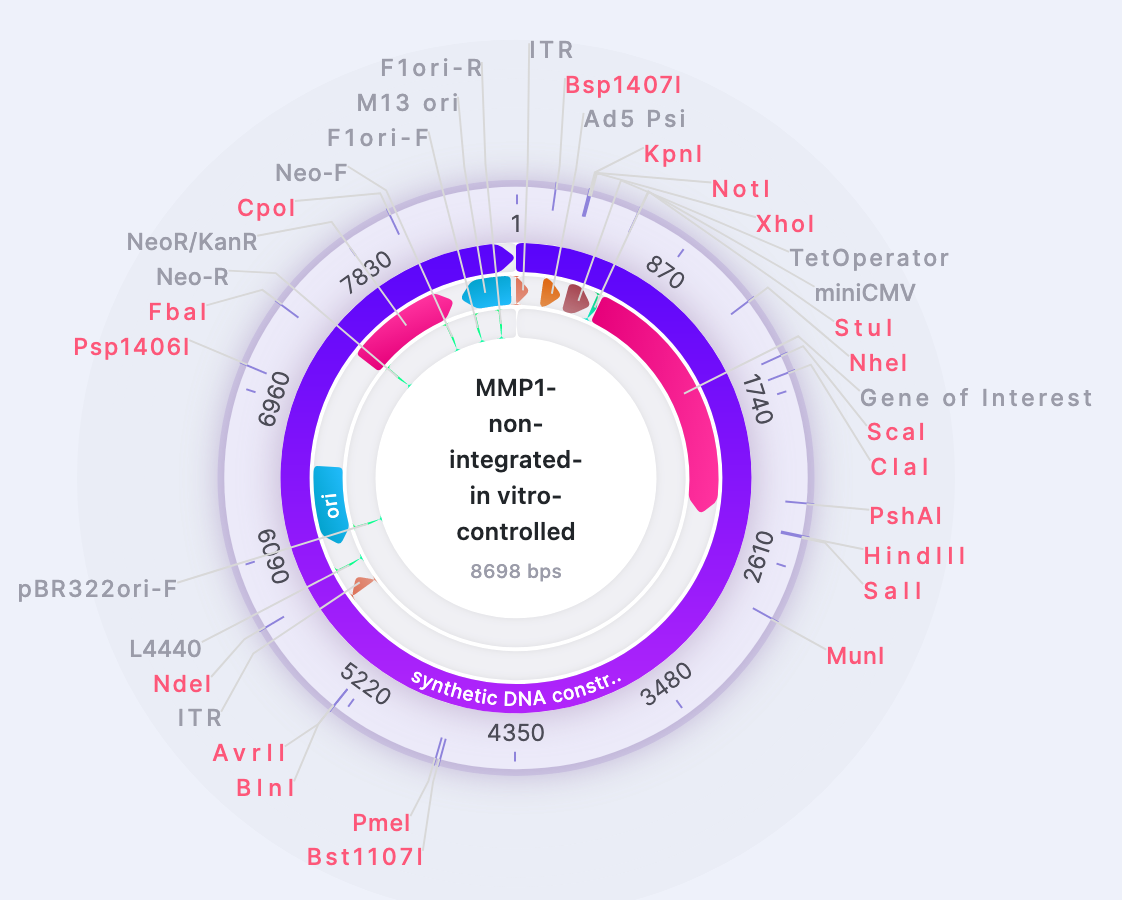
Main vector features:
- Ad5 Psi
- ITR
- M13 ori
- Mini CMV
- NeoR/KanR
- Ori
- Tet operator
6) Gene non-integrated + in vitro + expression uncontrolled – in heart
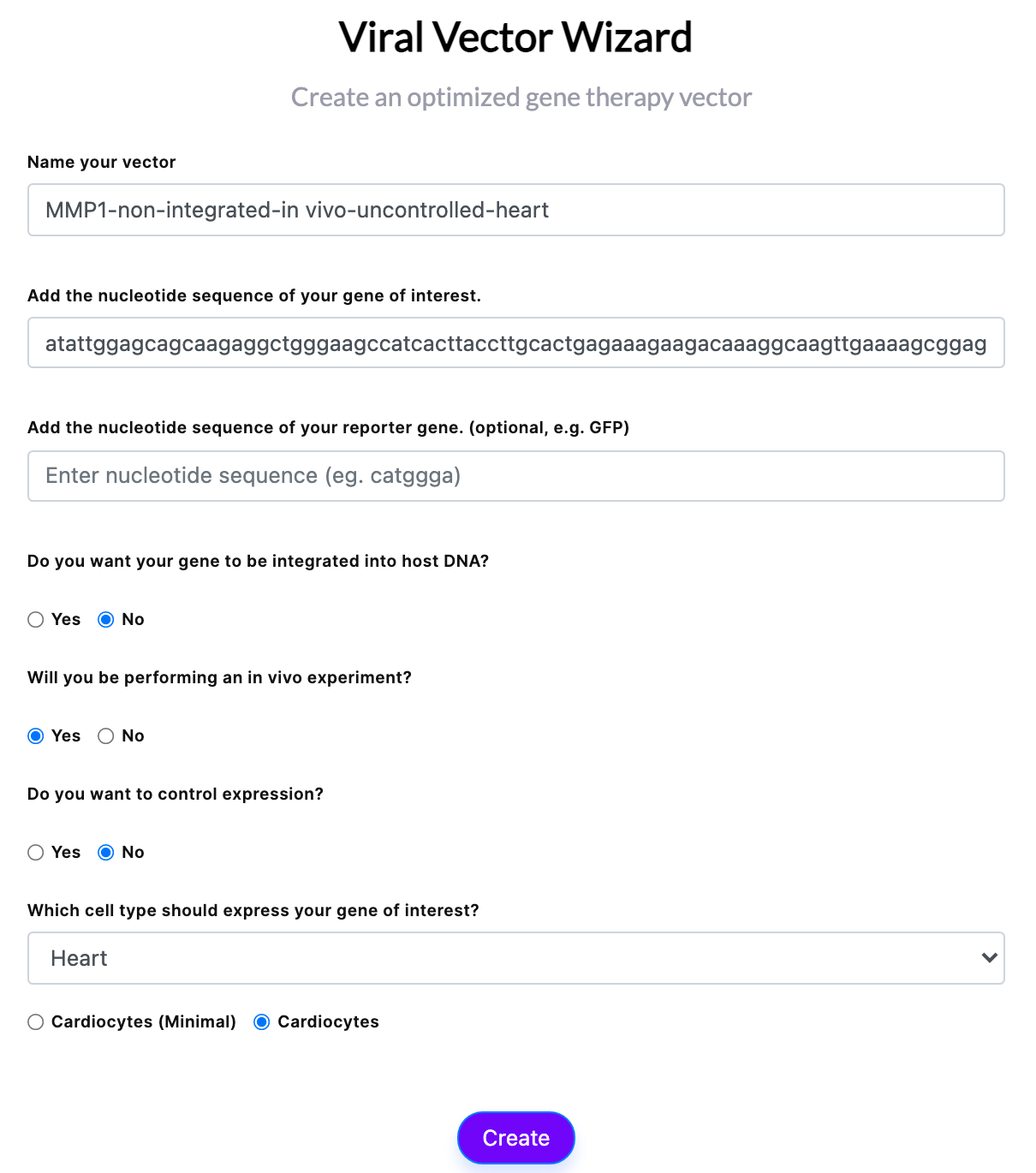

Main vector features:
- Ad5Psi
- Cardiac Tropin T promoter (tissue-specific promoter)
- ITR
- M13 ori
- NeoR/KanR
- Ori
The example of vector with reported gene (dsRed).
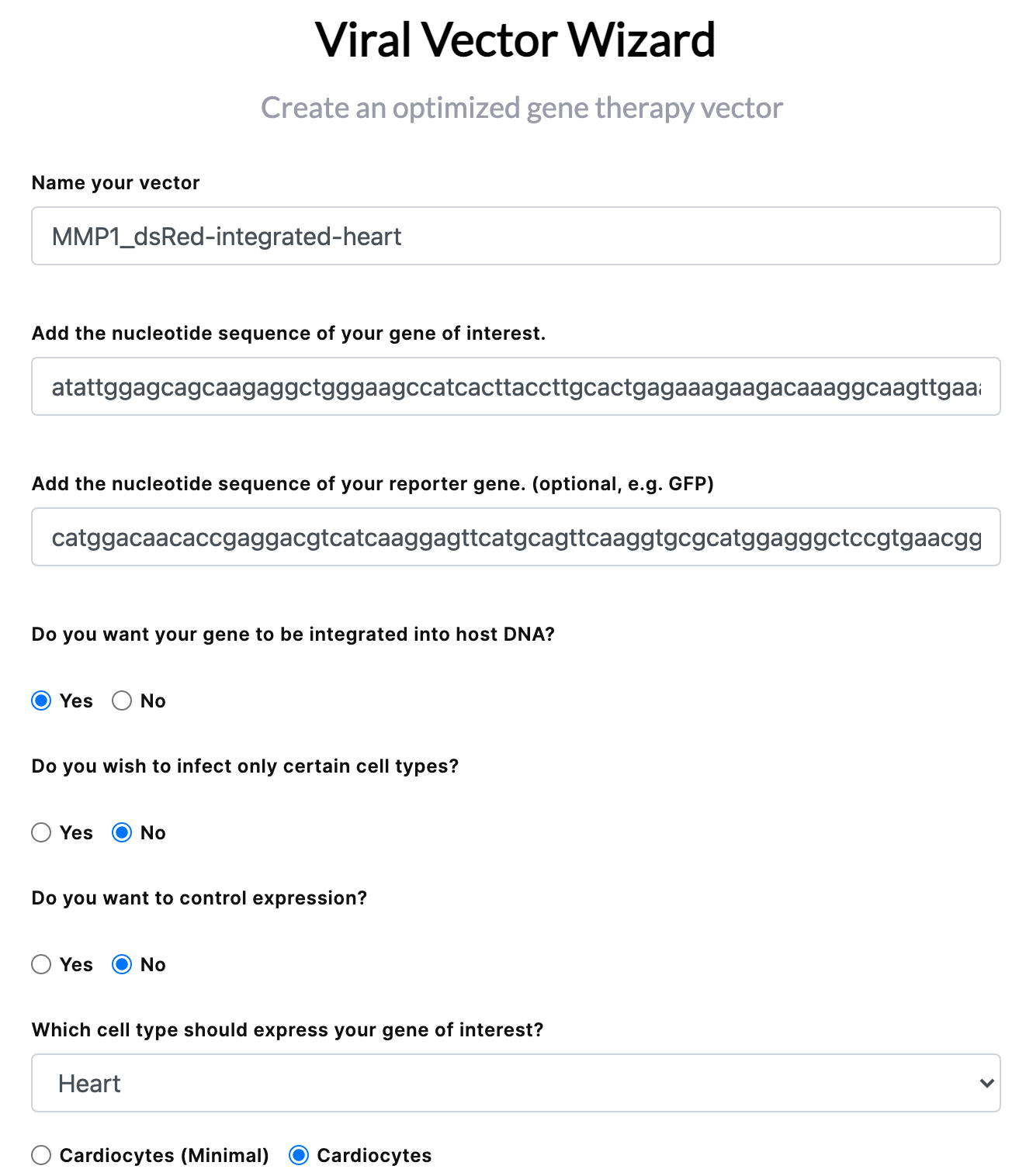
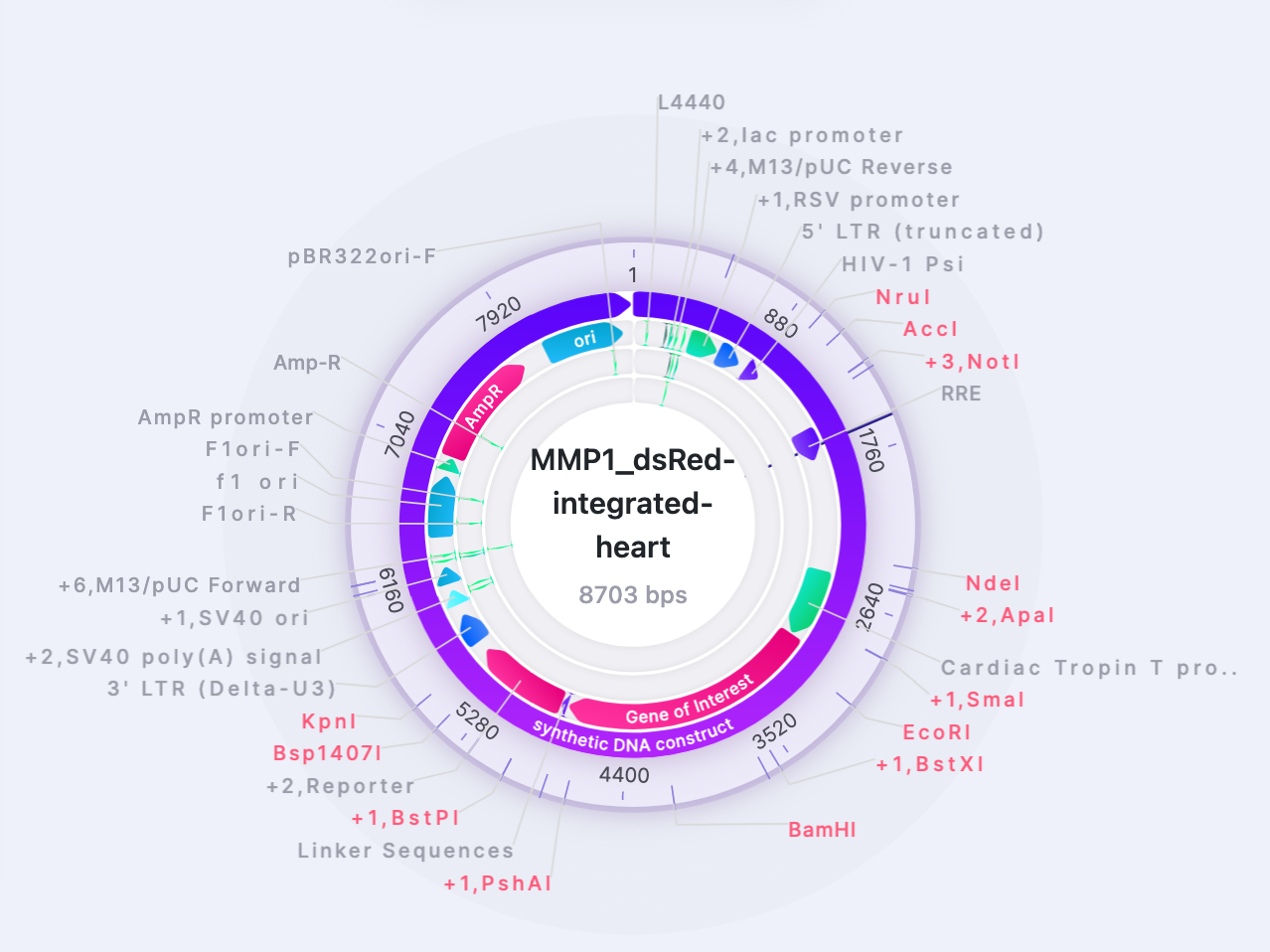
The reporter gene will be automatically added after the gene of interest, with a linker between them.
The default linker is (Gly4-Ser)3 (Gly-Gly-Gly-Gly-Ser sequence – three repeats)GGTGGTGGTGGTAGCGGTGGTGGTGGTAGCGGTGGTGGTGGTAGC
Appendix
Notes to specific parts of the vector used in vector wizard tool.
| 3’LTR (Delta-U3) | self-inactivating 3' long terminal repeat (LTR) from HIV-1 |
| 5’LTR truncated | truncated 5' long terminal repeat (LTR) from HIV-1 |
| AAV2 ITR | inverted terminal repeat of adeno-associated virus serotype 2 |
| AAV2 ITR (alternate) | Functional equivalent of wild-type AAV2 ITR |
| Ad5 Psi | packaging signal for adenovirus serotype 5 |
| AmpR | confers resistance to ampicillin, carbenicillin, and related antibiotics |
| AmpR promoter | na |
| CAP binding site | CAP binding activates transcription in the presence of cAMP. |
| EF-1-alpha core promoter | core promoter for human elongation factorEF-1-alpha |
| F1 ori | f1 bacteriophage origin of replication |
| HIV-1 Psi | packaging signal of human immunodeficiency virustype1 |
| ITR | inverted terminal repeat of human adenovirus serotype 5 |
| Lac operator | lac repressor encoded by lacI. The lac repressor binds to the lac operator to inhibit transcription in E. coli. This inhibition can be relieved by adding lactose or isopropyl-beta-D-thiogalactopyranoside (IPTG). |
| Lac promoter | promoter for the E. coli lac operon |
| M13 ori | M13 bacteriophage origin of replication |
| Mini CMV | na |
| NeoR/KanR | confers resistance to neomycin, kanamycin, and G418(Geneticin(R)) |
| Ori | high-copy-number ColE1/pMB1/pBR322/pUC origin of replication |
| RRE | The Rev response element (RRE) of HIV-1 allows for Rev-dependent mRNA export from the nucleus to the cytoplasm. |
| RSV promoter | Rous sarcoma virus enhancer/promoter |
| SV40 ori | SV40 origin of replication |
| SV40 poly(A) signal | SV40 polyadenylation signal |
| Synthetic polyA signal | na |
| T3 promoter | promoter for bacteriophage T3 RNA polymerase |
| T7 promoter | promoter for bacteriophage T7 RNA polymerase |
| Tet operator | na |
| Vertebrate consensus sequence for strong initiation | vertebrate consensus sequence for strong initiation of translation (Kozak, 1987) |